With gorgeous trumpet-like flowers of pure white and a heady fragrance, Easter lilies (Lilium longiflorum) are a beloved springtime herald of hope and new growth – and you can transplant them into the garden after blooming!
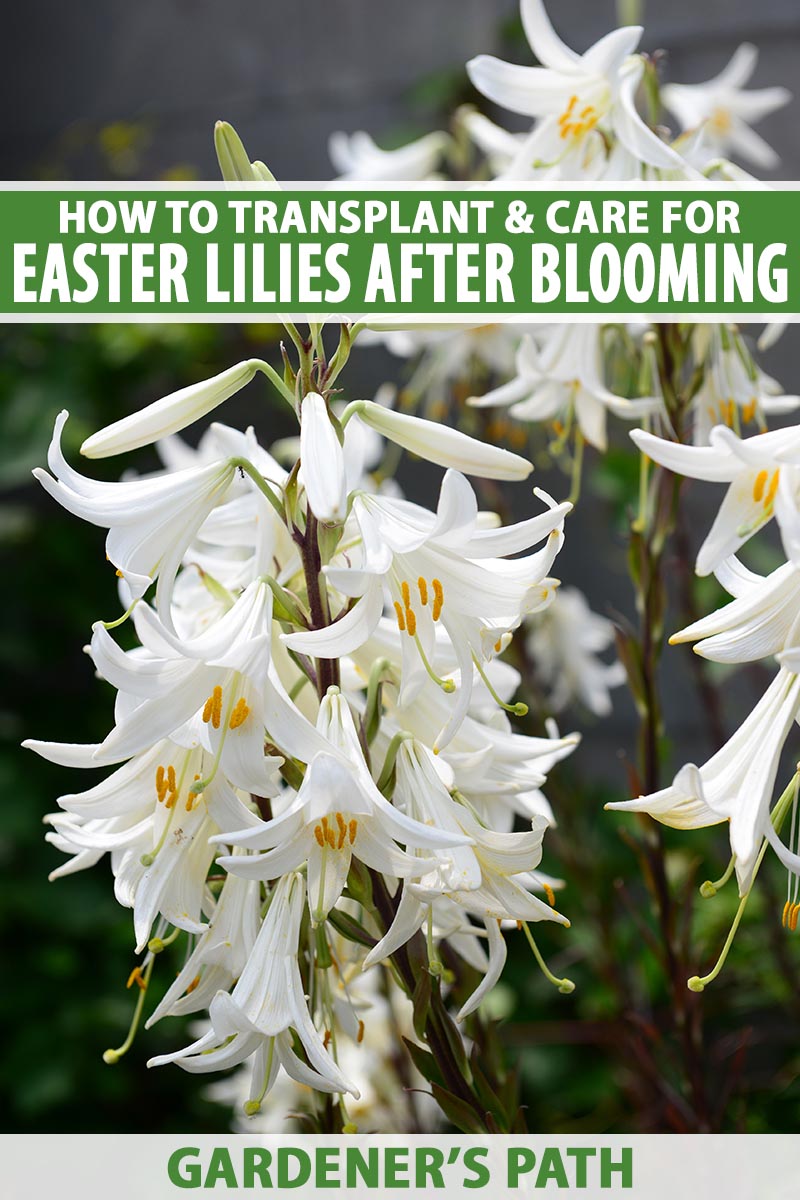
We link to vendors to help you find relevant products. If you buy from one of our links, we may earn a commission.
Out in the garden, L. longiflorum blooms in the summer months. But those cultivated as potted indoor plants have been forced to flower earlier, coinciding with the arrival of spring.
Once they’ve finished flowering, many folks simply dispose of them.
But these pretty perennial bulbs can easily be transplanted outdoors for garden growth, reverting back to their summer flowering time and providing many more seasons of beautiful blooms.
Would you like to extend the enjoyment of your potted Easter flowers? Then join us now for the easy steps on how to transplant and care for Easter lilies after blooming!
Here’s what’s covered:
What You’ll Learn
Easter Lily Basics
The Lilium genus is large and varied, with numerous species and cultivars available for the home gardener.
The potted flowers sold in shops in early spring known as Easter lilies are cultivars of the species L. longiflorum, and popularly used for holiday decor and as symbolic gifts.
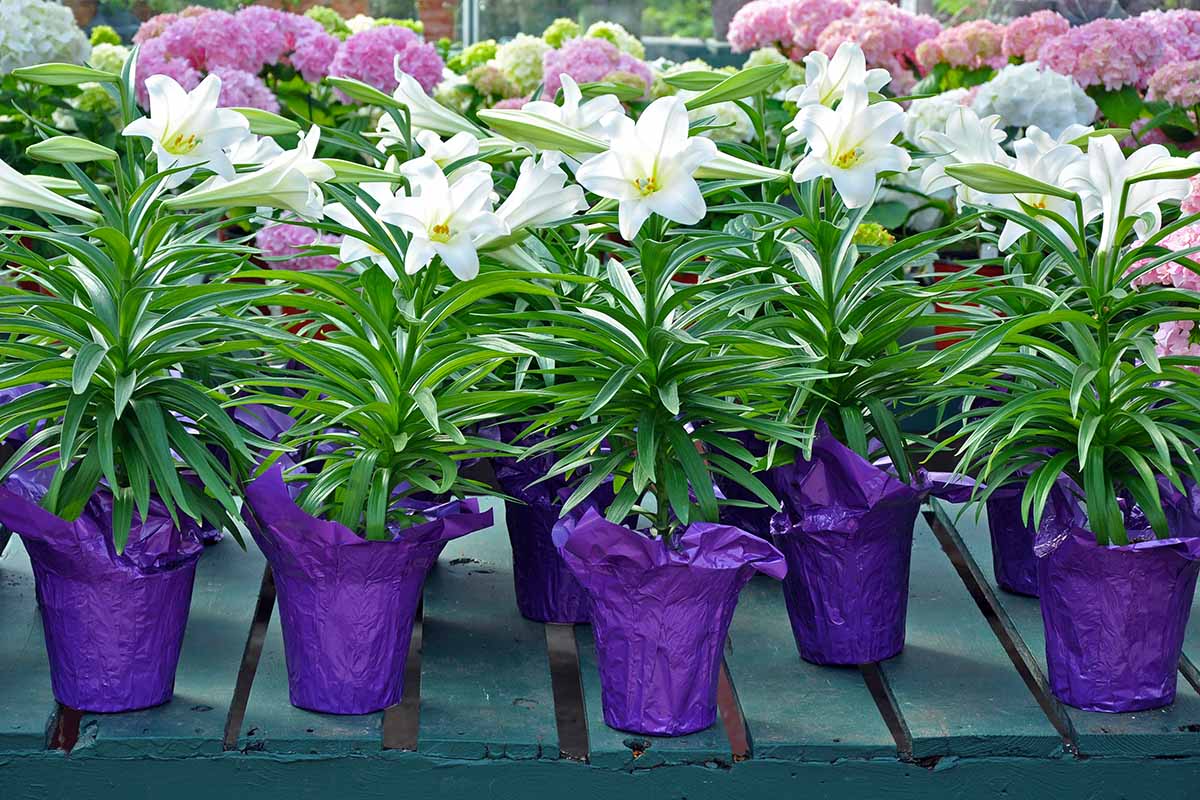
Native to Japan and Taiwan, this species and its cultivars make up the entire fifth division (Division V of IX) in the Royal Horticultural Society’s Lily Register – the authority on all things Lilium and a register of cultivars.
The trumpet-shaped flowers of pure white to pink are highly fragrant and outward-facing, with up to 12 or sometimes as many as 15 flowers per stem.
However, hybrids forced for indoor growth typically have fewer blooms, usually in the range of eight to 12 flowers per stem.
These upright plants grow one to three feet tall from perennial bulbs, forming thick, sturdy stems whorled with handsome oval leaves of dark green. The stems rarely require staking and plants are hardy in USDA Zones 4 to 8.
The large flowers are attractive to pollinators like bees and butterflies and make a beautiful, scented addition to beds, borders, and containers.
Plus, they make a superb flower for arrangements that deserves a spot in your cutting garden as well.
When planting outside, consider areas such as borders, alongside pathways, and in patio pots – or anywhere their soothing, perfumed flowers can be appreciated.
To learn more about the many lovely plants in this genus, read our guide to 27 of the best lily varieties.
Care After Flowering
Easter lilies bloom for two to three weeks indoors, and after flowering, they can be transplanted outdoors so you can enjoy them again.
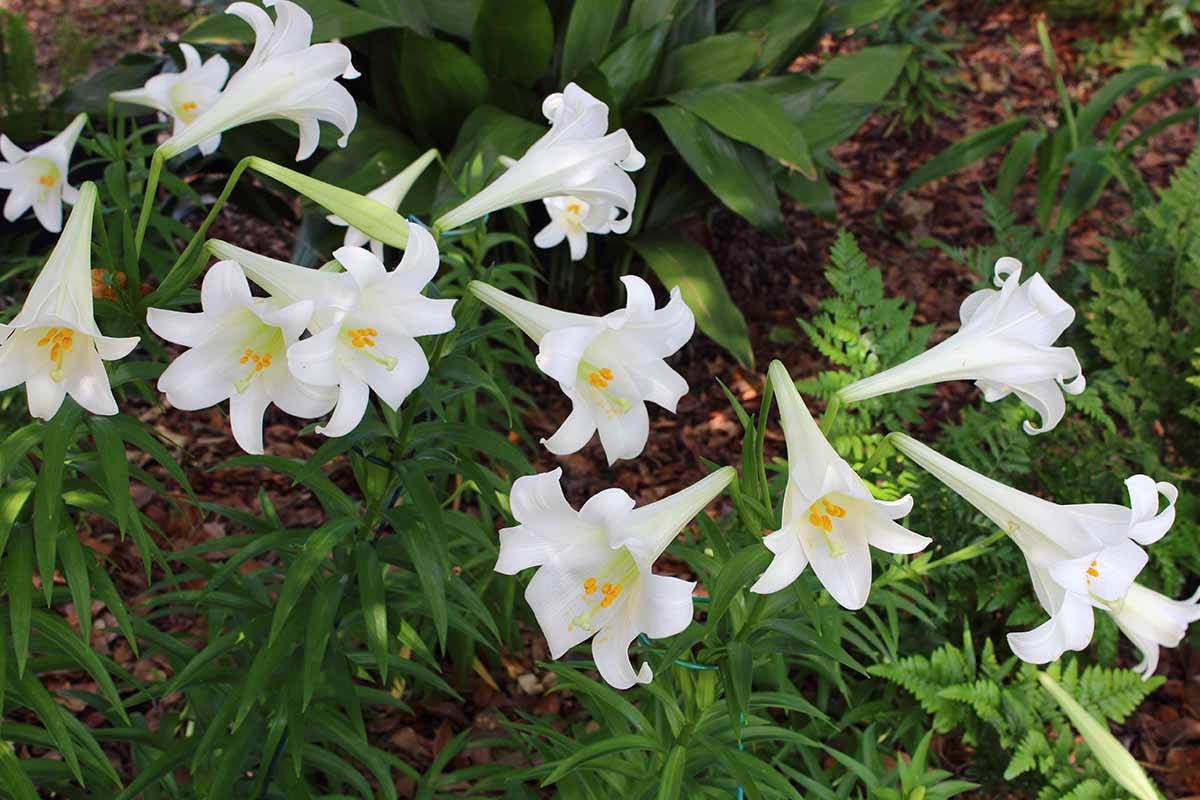
But to make a successful transition from home to garden, they need the right treatment after flowering. Don’t worry, it’s simple! Here’s what you need to do:
Once flowering has finished, use clean, sharp scissors to deadhead plants, removing flower stems close to the main stalk.
Move your plant to a brightly lit spot, but out of direct sunlight. Remove decorative wrappers from around pots and place them on a catchment tray to keep things dry and tidy.
They also need a location with temperatures between 65 and 75°F – the closer they are to the cool end of that range, the more they’ll like it.
Keep the soil lightly moist but not wet, and don’t allow the pots to sit in water for extended periods. Empty catchment trays if needed.
Every two weeks, feed your plants with a liquid houseplant fertilizer – the bulbs are building energy for the next flowering season.
Miracle-Gro Indoor Plant Food has a 1-1-1 NPK formula and is available at Home Depot.
Plant outdoors in May or when soil temperatures have warmed to 65°F.
Into the Garden
Before planting out, harden off your plants for a week or two to allow them to acclimate.
Place pots outdoors in a protected site with gentle morning sun and shade from hot afternoon sunlight for an hour or two on the first day. Each day, add a little more time until the plants are outdoors for a full day.
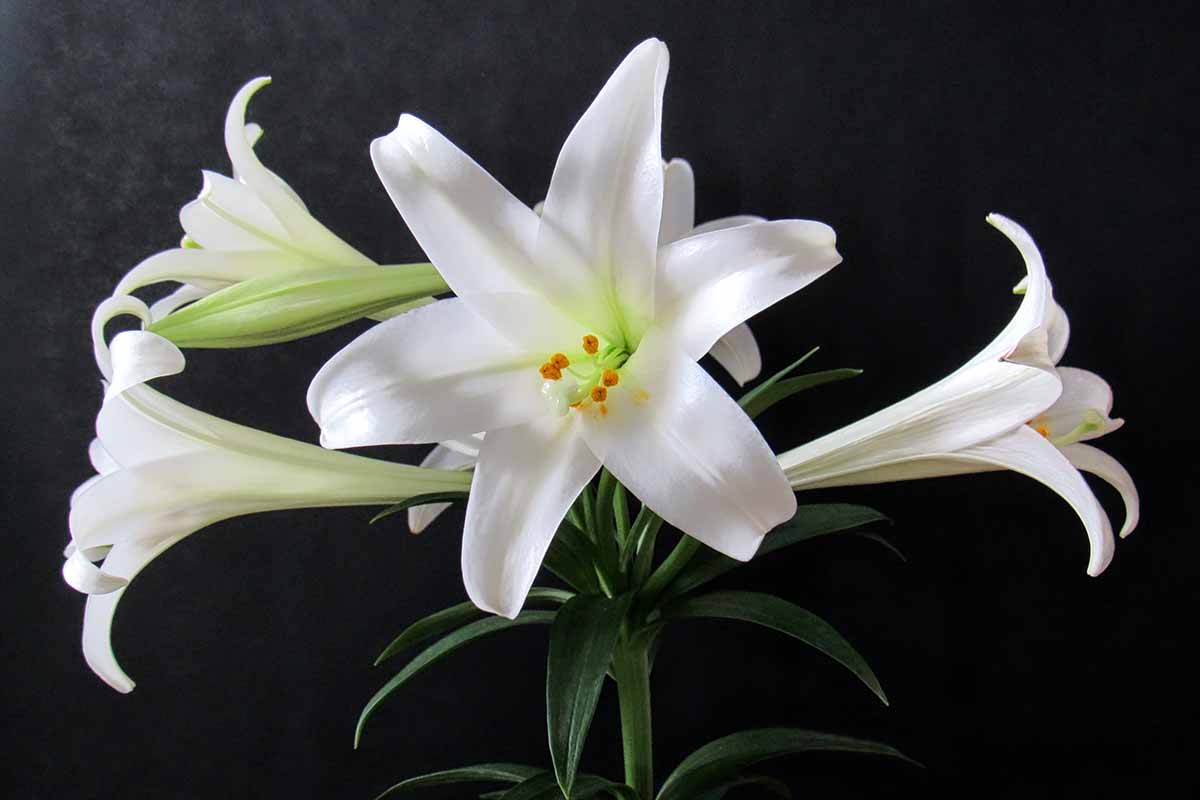
At this point you can leave pots outdoors overnight unless temperatures dip below 50°F.
Hardening off plants before they go into the garden helps to reduce transplant shock, heat stroke, and sunscald.
In the garden these perennial bulbs require a full sun to part shade location in humus-rich, lightly moist and well-draining soil with a slightly acidic to neutral pH of 6.5 to 7.0.
Prepare the planting site by loosening the soil to a depth of 12 inches with a garden fork or spade, breaking up lumps and removing debris.
Add in a shovelful of compost or well-rotted manure to enrich the soil.
To help the soil hold water, add a shovelful of moisture-retentive materials such as coconut coir, peat moss, perlite, or vermiculite.
If the drainage needs to be improved, mix in a shovelful of granite grit, landscape sand, or pea gravel. Well-draining soil is important for L. longiflorum because they like moist conditions, but bulbs can rot when the soil becomes overly wet.
To help maintain soil moisture, add a four-inch layer of summer mulch using materials such as bark mulch, leaf mold, or straw.
Mix in one to two tablespoons of bone meal to promote healthy roots – bone meal is rich in potassium, which plants use for strong, fast root growth.
Set the bulb and roots at the same depth as in the pot, or slightly deeper.
If plants have become rootbound, use your fingers to carefully loosen the roots and then spread them out in the planting hole.
Backfill and lightly firm the soil.
Water gently to settle in place, then water regularly to keep the soil lightly moist throughout the growing season.
How to Grow
After transplanting, the leaves and stems on your plant will turn brown and die back. But don’t panic – within a few weeks, strong new growth will emerge from the bulb!
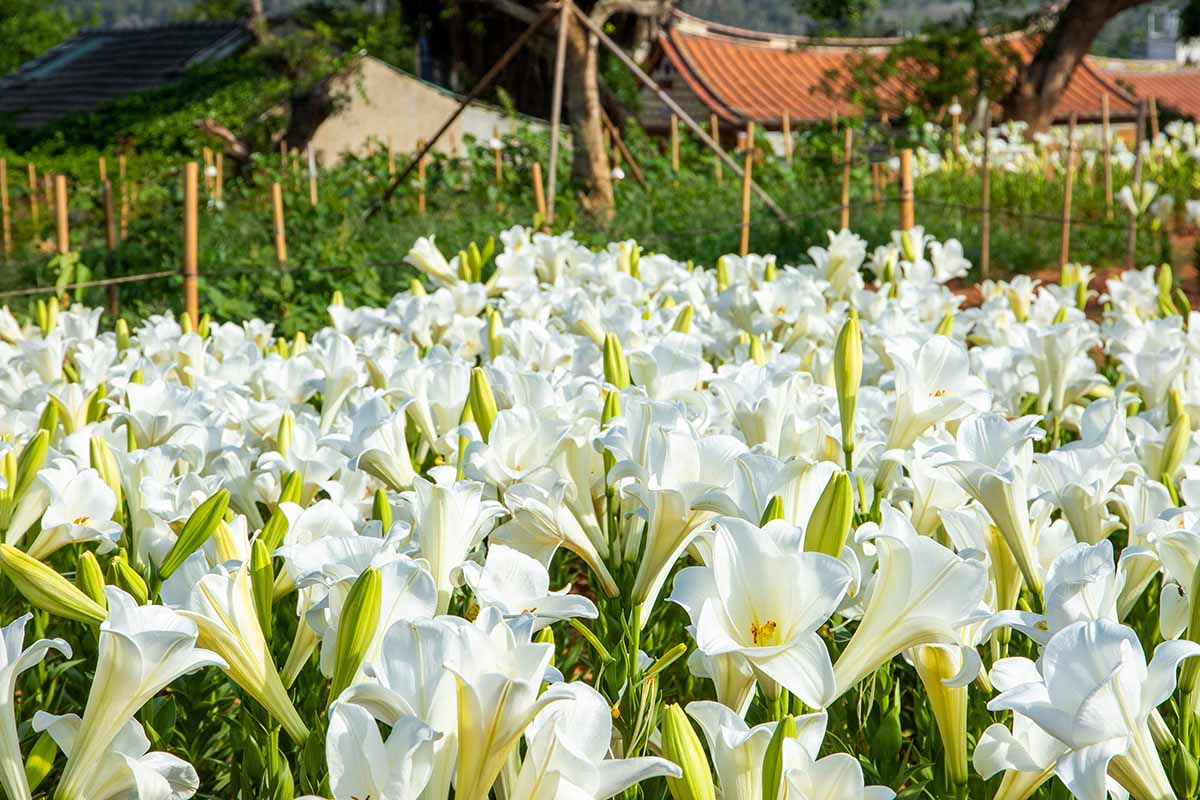
Remove dead plant material with clean, sharp shears.
After new growth is three inches tall, feed plants with a balanced 10-10-10 NPK fertilizer. Fertilize monthly with liquid or water-soluble fertilizers, or use slow-release pellets when planting with a repeat application in midsummer.
With a little luck, you might get a flowering stem in late summer, when temperatures start to cool down. However, most forced plants won’t rebloom until the following year.
In autumn, remove brown and wilted vegetative matter as plants die back, but don’t tug on the flower stems – doing so can easily dislodge the bulbs. Use clean, sharp garden shears to cut them instead, trimming stems to the ground.
L. longiflorum has good cold resistance and bulbs are hardy in Zones 4 to 8.
In colder regions within this range, provide plants with a four- to six-inch-thick winter mulch to reduce damage from freeze/thaw cycles. Use materials such as shredded leaves, straw, or pine boughs.
Remove the winter mulch in spring after all danger of frost has passed.
Container Care
Indoor potted plants can also be transplanted into larger outdoor containers and patio pots.
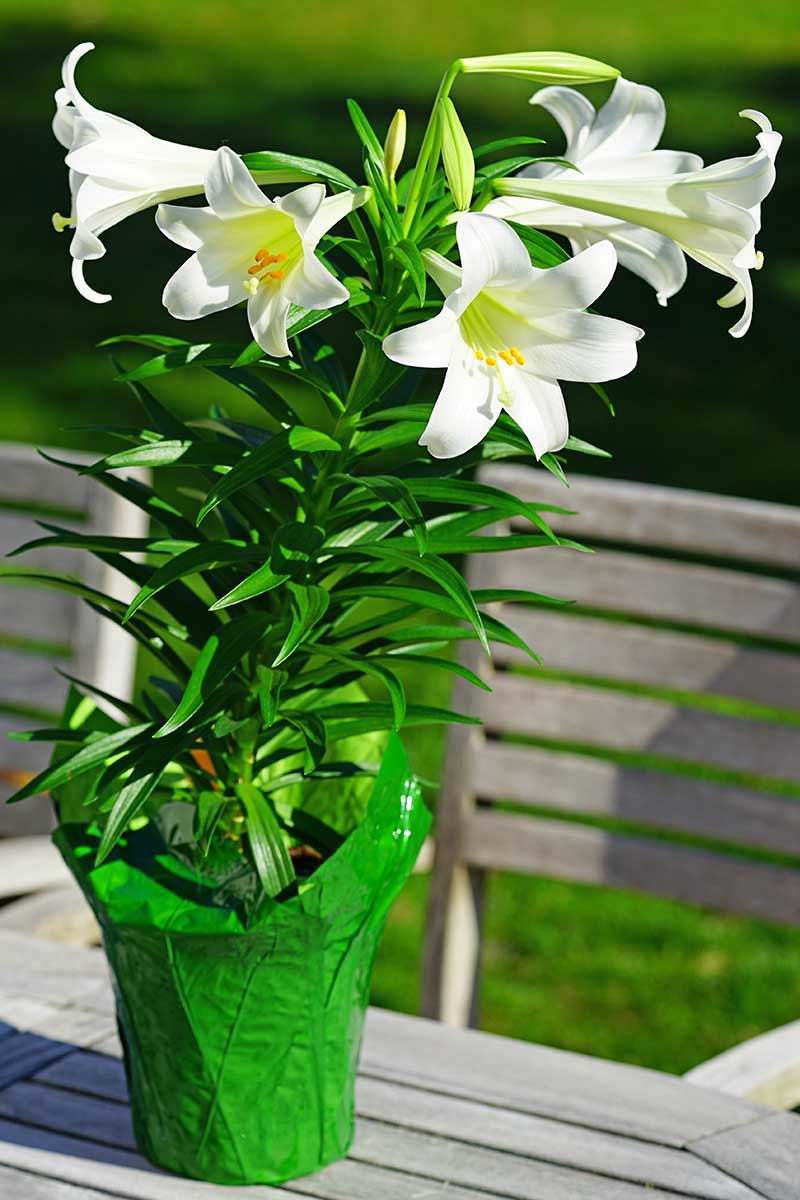
Use pots with drainage holes. I like to cover them with a two-inch layer of drainage materials such as broken pottery or pebbles.
Set containers in a full sun location and fill pots with a well-draining, humus-rich soil then plant as outlined above.
Keep the soil lightly moist and feed as noted for garden care.
If needed, provide a summer mulch to keep the soil cool and moist.
Provide containers with winter protection in cold regions, moving them into sheltered sites like next to fences and walls or in unheated garages and sheds.
Protect the bulbs with a thick winter mulch and provide a small sip of water every month to containers that are out of the rain – but skip the watering if the soil is frozen.
Move containers back once temperatures warm up and remove the winter mulch in spring.
Trumpets of Delight
The pure white, trumpeting flowers and intense perfume of Easter lilies are a delightful treat in the homescape that can easily be enjoyed outdoors as well.
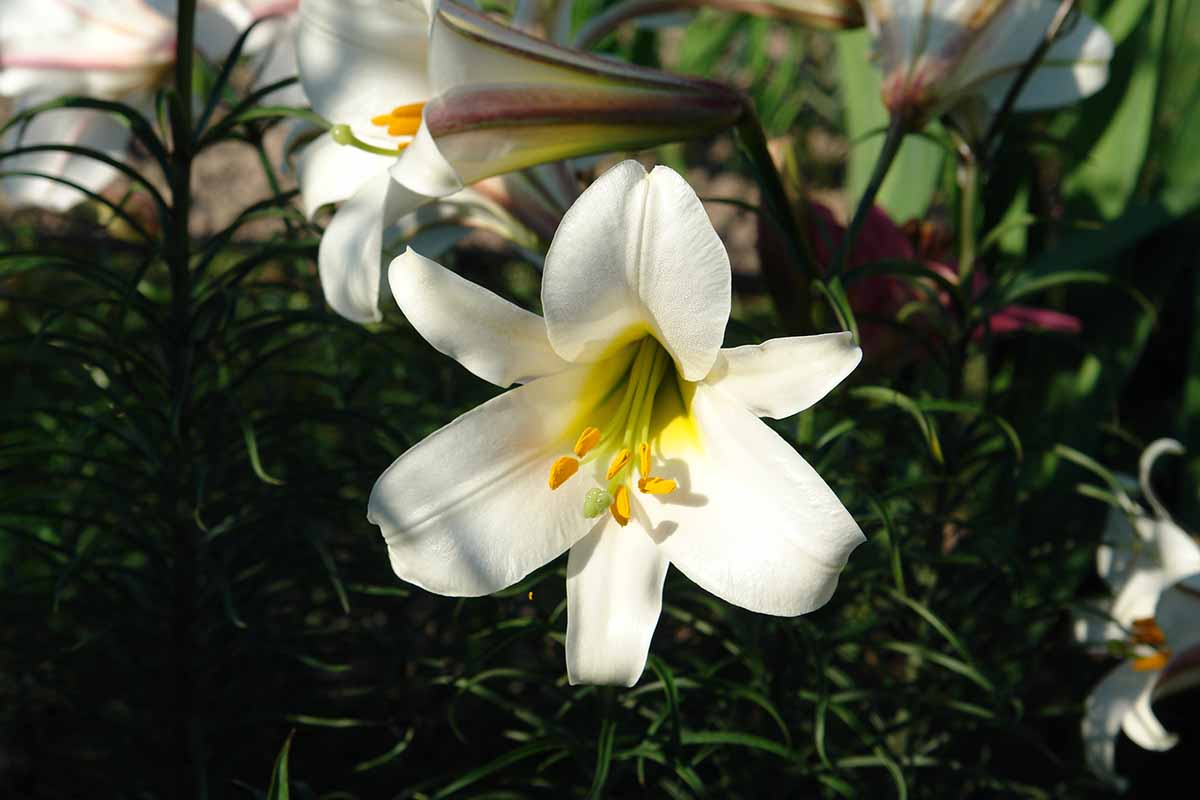
After flowering, keep them happy indoors with bright light, moist soil, and regular feeding.
Then when the temperatures are right, transplant out to the garden where these perennial bulbs can continue to delight for many seasons to come!
How do you folks use your potted Easter lilies in the garden? Let us know in the comments section below.
And for more know-how about growing lilies, add these informative guides to your reading list next:



